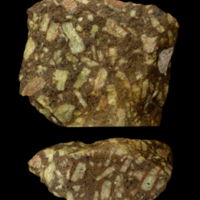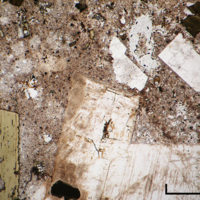- Home
- Rocks
- Type fossils
- Fossil Specimens
- Minerals
- Glossary
- Stratigraphic Chart
- Michel-Levy Chart
- Classification of igneous rocks
- University of Cambridge
- Department of Earth Sciences
- ESC Library
- Moodle
- Sedgwick Museum
- DoITPoMS
- Mindat.org
- Microfossils
- Bryozoans
- Webmineral
- Tree of Life
- CrystalMaker
- Virtual Microscope
L130 - porphyritic andesite
Age
Early Paleozoic
Location
Cansip Porphyry Sills
Sutherland
Hand Specimen
Porphyritic.
Large, tabular, pale grey-yellow phenocrysts of plagioclase feldspar, randomly oriented, twin striations are visible on many of them.
Pink-brown cryptocrystalline groundmass contains black, shiny flakes of biotite.
Thin-section
Plagioclase feldspar
- Euhedral phenocrysts, 2-20 mm long, displaying the characteristic lamellar twinning. Some alteration to white mica. In places they have been replaced by chlorite and calcite.
Biotite
- Phenocrysts, most <1mm long, with characteristic brown to pale straw pleochroism and straight extinction.
Accessory minerals
- Quartz
- Apatite
Groundmass
- Mainly cryptocrystalline. A small number of feldspar grains can be identified. Small ragged vesicles.
Rock History
Two-stage cooling: phenocrysts followed by groundmass.
Phenocrysts are euhedral indicating that they crystallised free-floating in a magma chamber.
The fine-grained groundmass must have crystallised rapidly due to cooling at the Earth’s surface.
Alteration occurred after crystallisation.
Rock Name
porphyritic andesite
porphyrite
porphyrite



